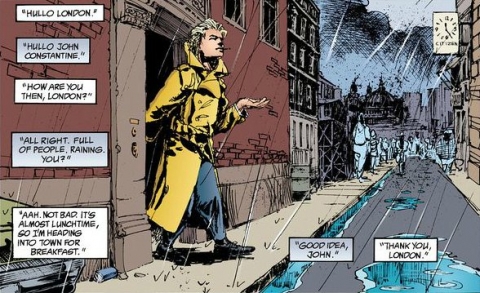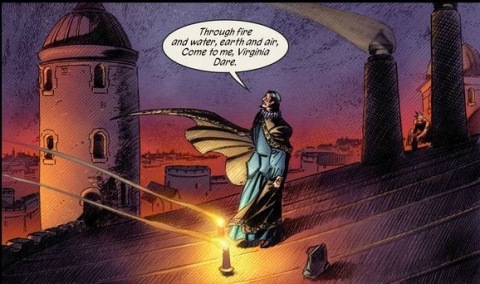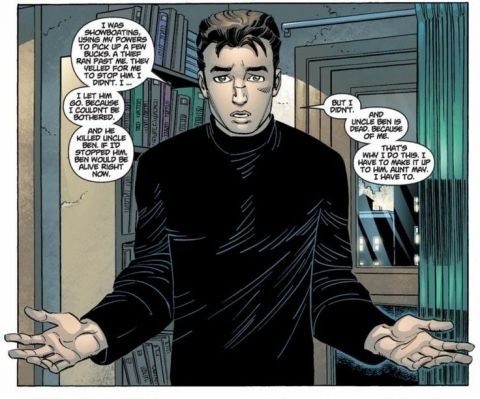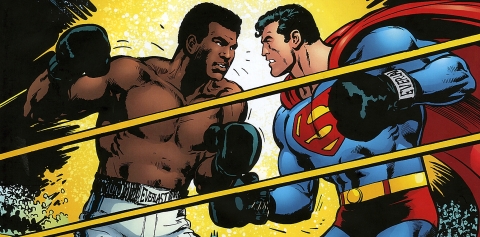52 weeks. 52 different writers. 2 trade paperbacks or hardcovers a week. Each week I’ll take a look at a different writer and read two different collected editions from within that person’s repertoire to help in the examination of their work.
Neil Gaiman’s first published comic stories were four short stories within the pages of the British comic, 2000 AD. Gaiman struck up a friendship with comic writer Alan Moore which eventually paved way to him taking over the comic title Miracleman after Moore left. After some other work, Gaiman was hired by DC Comics to write a series, with Gaiman’s initial treatment being for the golden age character of the Sandman. DC contacted Gaiman about writing a Sandman series but with an interesting catch, the Sandman Gaiman would have to write about would be an entirely new character of his creation. Thus, The Sandman was born over on the Vertigo imprint, intersecting with other popular characters like Swamp Thing and John Constantine from time to time. The Sandman was wildly successful in the graphic novel format, being one of the first graphic novels to emerge on to the New York Times Bestseller list. Since its debut, The Sandman has become a culturally iconic story, capturing the hearts and minds of young, impressionable readers.
The Sandman Volume 1: Preludes and Nocturnes
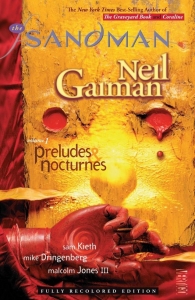 Roderick Burgess, otherwise known as the “Daemon King”, is a man deeply rooted in the occult and powerful dark magic, leading the Order of Ancient Mysteries. A greedy man, Burgess seeks to capture Death and avoid aging in an attempt to become immortal. His ritual to summon and capture Death falls short though as he ends up capturing Death’s brother, Dream, instead. As a result, both the mortal plane and Dream’s own domain are thrust into a state of turmoil, with innocent people falling into eternal sleep whilst Dream’s kingdom decays. After decades of keeping Dream captured, Roderick eventually succumbs to his old age and leaves the burden on his son Alex. For over seventy years Dream remains trapped in the Burgess estate, being robbed of physical items that are key for his control over the “dreamstate”. A pouch with magic dust, a helmet, and a ruby are all taken from him and dispersed across the world, falling into the hands of several unlikely suitors. Dream sets out to escape from his prison and seek revenge on the Burgess family before going on a hunt to find these three important artifacts. On his quest to find his belongings, Dream quickly discovers just how much his absence for seventy years has effected the world as we know it.
Roderick Burgess, otherwise known as the “Daemon King”, is a man deeply rooted in the occult and powerful dark magic, leading the Order of Ancient Mysteries. A greedy man, Burgess seeks to capture Death and avoid aging in an attempt to become immortal. His ritual to summon and capture Death falls short though as he ends up capturing Death’s brother, Dream, instead. As a result, both the mortal plane and Dream’s own domain are thrust into a state of turmoil, with innocent people falling into eternal sleep whilst Dream’s kingdom decays. After decades of keeping Dream captured, Roderick eventually succumbs to his old age and leaves the burden on his son Alex. For over seventy years Dream remains trapped in the Burgess estate, being robbed of physical items that are key for his control over the “dreamstate”. A pouch with magic dust, a helmet, and a ruby are all taken from him and dispersed across the world, falling into the hands of several unlikely suitors. Dream sets out to escape from his prison and seek revenge on the Burgess family before going on a hunt to find these three important artifacts. On his quest to find his belongings, Dream quickly discovers just how much his absence for seventy years has effected the world as we know it.
Neil Gaiman combines psychological horror with vivid fantasy to bring forth one of the strongest pieces of fiction composed for comics with The Sandman. This first volume is a rich and fascinating combination of the two genres mentioned above in a way that keeps you locked in as the story picks up. Although the first volume is largely dominated by the psychological horror aspect of the story, Gaiman still sprinkles in just enough fantastical elements to show you where the story is going instead of just leaving you feeling complacent and experiencing where it is currently rooted. In casting the “King Of Dreams” (or Morpheus as he’s often referred to in the story) as the lead character, Gaiman is afforded a unique opportunity in how he decides to angle the character. When you take into account how calm and beautiful the act of dreaming is regarded as, it’s an interesting juxtapose to see how much more troubling Gaiman presents it as through this story. One would often associate nightmares with the negative side of dreaming, with nightmares being dark and psychologically disturbing unconscious thought, but Gaiman goes even further than that and shows the dark side of dreaming that isn’t simply referred to as nightmares. Toying with things like eternal sleep or the acting of always waking aren’t something you’d necessarily see as being nightmare material when you just read the words, but Gaiman makes these sort of ideas some of the most terrifying state of beings you’ll ever see on a comic book page.
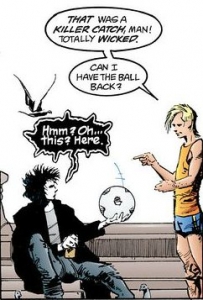 Delving into the story, there are both strong and weak aspects to it. As I stated in the previous paragraph, one of the greatest triumphs this story has going for it is the genre blend it plays with in unison with Gaiman’s thick writing that can evoke so many different emotions from you at once. Each issue takes the horror with the fantasy and makes this interesting mix of themes you can’t look away from. Whilst some issues perfectly capture the side of horror that deals with a creeping sense of inevitability, such as the first issue, other issues straight up delve into the dark and psychologically tortured side of it, much like issue three. Meanwhile, you still get these high concept elements that are essential to the fantasy genre, like the things Morpheus encounters when he travels to Hell in the fourth issue. Although all these parts of the story are great, it isn’t without faults as sometimes the plot can just feel aimless. The most prominent example of this is definitely the first issue that captures seventy years of time passed, accelerating you to the true starting point of the story by the end of the issue. To be fair, I’m not a particularly huge fan of time jumps so unfolding a story over seventy years in just one issue feels odd to me but the writing is still on point enough that the issue is still an enjoyable read. The first two issue overall are definitely vital in the sense that they give the character of Morpheus some directions to follow but on their own their plot just doesn’t quite hit the mark. It’s after you get to issue three that the series seems to truly start to flourish as Morpheus begins to explore some truly interesting settings.
Delving into the story, there are both strong and weak aspects to it. As I stated in the previous paragraph, one of the greatest triumphs this story has going for it is the genre blend it plays with in unison with Gaiman’s thick writing that can evoke so many different emotions from you at once. Each issue takes the horror with the fantasy and makes this interesting mix of themes you can’t look away from. Whilst some issues perfectly capture the side of horror that deals with a creeping sense of inevitability, such as the first issue, other issues straight up delve into the dark and psychologically tortured side of it, much like issue three. Meanwhile, you still get these high concept elements that are essential to the fantasy genre, like the things Morpheus encounters when he travels to Hell in the fourth issue. Although all these parts of the story are great, it isn’t without faults as sometimes the plot can just feel aimless. The most prominent example of this is definitely the first issue that captures seventy years of time passed, accelerating you to the true starting point of the story by the end of the issue. To be fair, I’m not a particularly huge fan of time jumps so unfolding a story over seventy years in just one issue feels odd to me but the writing is still on point enough that the issue is still an enjoyable read. The first two issue overall are definitely vital in the sense that they give the character of Morpheus some directions to follow but on their own their plot just doesn’t quite hit the mark. It’s after you get to issue three that the series seems to truly start to flourish as Morpheus begins to explore some truly interesting settings.
Now when we talk about the settings, it’s important to mention for some readers that Sandman actually takes place within the DC Universe. Vertigo is like the baby sister publisher of DC Comics and is responsible for spawning well-known characters like John Constantine (who makes a lovely appearance in this first volume) and Swamp Thing. So some readers will come into this story without realizing that it is set in a universe with superheroes even though they don’t factor too heavily into the overall plot. Even still, it’s a terrific amount of fun for a superhero fan to see well-known settings like Arkham Asylum pop up and play a role. The Sandman takes place in a different setting with almost each and every issue, whether it be in Morpheus’ dreamlike domain, the aforementioned Arkham Asylum, average places like a 24-hour diner, or even Hell. No matter where the story takes you, Gaiman and company always manage to whisk you along to a completely different environment, chalked full of new and exciting obstacles for Morpheus to face.
One of the most enjoyable parts of The Sandman has to be the eclectic cast that Neil Gaiman chooses to work with. Morpheus is the lead character who is clearly presented to you as the hero but doesn’t necessarily feel like a heroic character. As a matter of fact he is self-serving but for a greater cause, something that is brilliantly addressed in the final issue of this collection through the inclusion of his sister, Death. Everything that Morpheus does in this story is to help him regain his power and control over the “dreamstate”. His reason for this is so that he can protect innocent people as they sleep and make sure the world doesn’t spiral into chaos with the world being deprived of sleep, of which is often done in this story as Morpheus tries to get his powers back. Even with that in mind, and the story often centring on these people and how it affects them, Morpheus is still all about trying to become as powerful as he used to be. Seldom does he phrase his words as “…to help these people” or something to that effect.
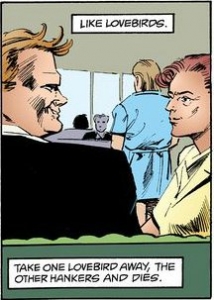 Other characters who factor into the story are only around for one or two issues but more often than not leave their mark, another fact that Gaiman should be tremendously proud of as he writes these fully fledged characters in such a small amount of pages. DC and Vertigo characters like Mr. Miracle, John Constantine, Martin Manhunter, and Doctor Destiny to name a few all play roles in the story but not in ways that steal the spotlight from Morpheus. Instead these characters actually play large parts in helping Morpheus recover the items he’s missing. These popular characters do an utterly fantastic job of grounding out both human and fantastical elements of this story, with John Constantine adding a gut wrenching and heartbreaking sense of sadness to the issue he appears in whilst Doctor Destiny plays up the idea of absolute power corrupting absolutely. Gaiman handles these supporting members in human ways that remind you that whilst this volume is a horror/fantasy story, it still takes place in a world that is fully realized.
Other characters who factor into the story are only around for one or two issues but more often than not leave their mark, another fact that Gaiman should be tremendously proud of as he writes these fully fledged characters in such a small amount of pages. DC and Vertigo characters like Mr. Miracle, John Constantine, Martin Manhunter, and Doctor Destiny to name a few all play roles in the story but not in ways that steal the spotlight from Morpheus. Instead these characters actually play large parts in helping Morpheus recover the items he’s missing. These popular characters do an utterly fantastic job of grounding out both human and fantastical elements of this story, with John Constantine adding a gut wrenching and heartbreaking sense of sadness to the issue he appears in whilst Doctor Destiny plays up the idea of absolute power corrupting absolutely. Gaiman handles these supporting members in human ways that remind you that whilst this volume is a horror/fantasy story, it still takes place in a world that is fully realized.
One thing that truly aids in the human-like nature of these characters and the story is Gaiman’s choice of dialogue as well as the captions. There’s a distinct difference in the way Morpheus speaks as opposed to someone like Constantine or Beelzebub. Gaiman ensures the reader that everyone has a unique voice, with Morpheus have this almost commanding tone in the way he approaches retrieving his lost items whilst still striking this sort of soft-spoken nature in his down beat moments. Characters like Beelzebub and Doctor Destiny speak almost erratically, making them come off as sick, twisted, and hard to relate to while someone like Constantine is cocky yet sincere. The richness of Gaiman’s captions, that so easily set a scene, are only further complimented by the almost quixotic art of Mike Dringenberg. Moods, themes, and tones all come through with ease every single time Gaiman sets a page with a caption or a piece of dialogue, leaving the reader with a true treat no matter where they set their eye.
Collects: The Sandman #1-8.
Best Character: Doctor Destiny.
Best Line Of Dialogue/Caption: “I am hope.” – Morpheus.
Best Scene/Moment: Morpheus and Constantine try to recover the pouch – Issue 3.
Best Issue: Issue 6 – 24 Hours. Issue 6 runs away from the pack in a collection of incredibly strong issues. Why? It’s an issue that features a bunch of random characters and Doctor Destiny abusing his new-found power. Over the course of twenty-four hours, Doctor Destiny completely and utterly dismantled the lives of these strangers, dissecting their psyche in cruel and brutal ways. You watch the characters range from orgasmic to melancholy, terrified to feral, and everything in between. The larger theme at play in the issue is the age-old proverb of “absolute power corrupts absolutely” but underneath it you still have a fascinating character driven issue where you empathize with these complete strangers who are essentially sheep lead to slaughter. The way Gaiman gives you an inevitable sense of horror that you can’t look away from is simply brilliant as this is one of the finest issues of a horror comic you’ll ever read. Great stuff.
Why You Should Read It: Sandman is a comic for mature readers who are looking for something more than just escapism from a comic book. The fantasy genre done well in comics is hard to do but it’s something that Gaiman does with ease, beautifully blending it with a psychological horror style to give readers one of the finest works in comic fiction. He turns characters into all-stars in single issues, makes you feel sad, happy, scared, and angry at the drop of a hat, and somehow still manages to tell a compelling story in between all of that. If you’ve never bothered to read The Sandman, you should start now because you’re definitely in for a treat.
Marvel 1602
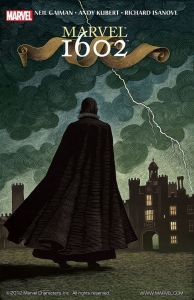 Neil Gaiman has only ever written two limited series by himself for Marvel comics, penning Marvel 1602 and The Eternals. Marvel editor Joe Quesada tracked Gaiman down to work on a project for Marvel back in the fall of 2001. Gaiman had no idea what type of story he wanted to write but following September the 11th, Gaiman realized that he wanted to take it as far away from the modern days as he could muster. After a trip to Venice, everything started to fall into place for Gaiman, being inspired by the city that grips so tightly to its past styles of art.
Neil Gaiman has only ever written two limited series by himself for Marvel comics, penning Marvel 1602 and The Eternals. Marvel editor Joe Quesada tracked Gaiman down to work on a project for Marvel back in the fall of 2001. Gaiman had no idea what type of story he wanted to write but following September the 11th, Gaiman realized that he wanted to take it as far away from the modern days as he could muster. After a trip to Venice, everything started to fall into place for Gaiman, being inspired by the city that grips so tightly to its past styles of art.
Set in the year 1602 across both Europe and England, mysterious storms are threatening the fabric of reality. Classic Marvel heroes and villains take root in this Elizabethan era, combatting magic and mystery in ways never seen before. Doctor Stephen Strange, the court Magician of Queen Elizabeth has an unwary sense that danger and destruction is afoot, rapidly approaching everyone and everything. Queen Elizabeth, gravely ill but desperate for a solution, contacts Sir Nicholas Fury to track a secret weapon that the Templar Knights are transporting from Jerusalem, believing it to have some tie to the unnatural storms effecting the world. Fury, along with his young steward Peter Parquagh, contact the mysterious Matt Murdock, a blind man, to track the Templar and then acquire the item. In England, Carlos Javier focuses his efforts on training “witchbreed”, young men and women who have exceptional powers but are revered as witches because of it. King James of Scotland seeks to usurp Queen Elizabeth and become the King of both England and Scotland. With an assassination attempt in place to take Queen Elizabeth’s life, King James sets out to blame the “witchbreed” for the assassination so that he can turn everyone against them as he rises into power. Meanwhile, Virgina Dare and her mysterious bodyguard Rohjaz arrive in England to meet with the Queen, bringing with them even more mystery and intrigue.
Neil Gaiman sets forth to tell a multi-layered and a completely different take on the Marvel universe with Marvel 1602. Witchcraft, sorcery, politics, murder, and many more themes play a dynamic role in this story that tackles just about every classic Marvel character and faction you could think of in this brisk, eight-issue mini-series. It’s the best type of history lesson as it tackles the Elizabethan era with comic book characters and sensibility but feels far more folklore than gimmicky. It would be easy for anyone to toss superheroes in the 17th century and modify their tights or cowls to work but Gaiman does something special with 1602, shying away from the distinct visuals that readers associate with superheroes and instead focuses on making these characters memorable through their actions. That’s not to say that there aren’t visual cues that give way to recognizing a character immediately, like an eyepatch for Nick Fury, Carlos Javier (who is supposed to be Charles Xavier of the X-Men) being paralyzed from the waist down, or even throwing a blindfold over the blind hero Matt Murdock a.k.a. Daredevil. Also don’t take my words as a way of saying that Andy Kubert’s artwork isn’t excellent (because it most certainly is), it’s just that Gaiman puts a larger emphasis on making you recognize characters for the way they act instead of the way they look, which is brilliant yet risky in a creative medium that lives and dies on artwork for interpretation. There are certain characters that Gaiman even hides within plain sight, further proving that you need to trust how a character is portrayed instead of just how they appear.
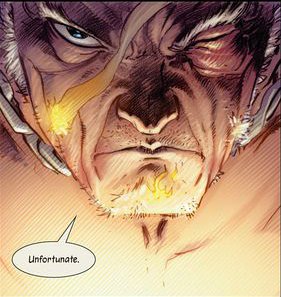 Obviously, fans of the Marvel universe will take the most away from this series but I implore fans of historical fiction to read this series as well. This book is so much more than a superhero book, feeling more fantasy than superhero as it roots itself in mysticism and witchcraft. Instead of being traditionally known as mutants, the “X-Men” are actually referred to as witchbreed, enhancing the 17th century elements of the story. It makes more sense for people during this time period to believe in magic as opposed to suspending their disbelief and seeing superheroes as something that verges on the realm of possibility. It matches up with the way of life during that time period as witch hunts and anything thought to be magical was often vilified before promptly being destroyed. In spinning the X-Men as witchbreed, Gaiman is able to update the characters so that they are historically sound but he even goes a step further with the way he handles other characters such as Rohjaz, Enrique, and countless others. Rohjaz is a muscular Indian man who is tasked with guarding Virginia Day, exuding all facets of how Indians were viewed at the time. The character speaks with brief words and embodies the supposed savagery that common folk associated with Indian culture upon that time. With the character of Enrique, Gaiman aligns the ideals of the character Magneto with the role of an inquisitor, making his official role actually be “The Inquisitor” for much of the story, hellbent on seeing death brought to those of whom are witchbreed. It’s a brilliant comparative thread between the role of an inquisitor and the key characteristics of the villain Magneto, demonstrating Gaiman’s surprisingly deep understanding of the characters while modifying them for the 17th century.
Obviously, fans of the Marvel universe will take the most away from this series but I implore fans of historical fiction to read this series as well. This book is so much more than a superhero book, feeling more fantasy than superhero as it roots itself in mysticism and witchcraft. Instead of being traditionally known as mutants, the “X-Men” are actually referred to as witchbreed, enhancing the 17th century elements of the story. It makes more sense for people during this time period to believe in magic as opposed to suspending their disbelief and seeing superheroes as something that verges on the realm of possibility. It matches up with the way of life during that time period as witch hunts and anything thought to be magical was often vilified before promptly being destroyed. In spinning the X-Men as witchbreed, Gaiman is able to update the characters so that they are historically sound but he even goes a step further with the way he handles other characters such as Rohjaz, Enrique, and countless others. Rohjaz is a muscular Indian man who is tasked with guarding Virginia Day, exuding all facets of how Indians were viewed at the time. The character speaks with brief words and embodies the supposed savagery that common folk associated with Indian culture upon that time. With the character of Enrique, Gaiman aligns the ideals of the character Magneto with the role of an inquisitor, making his official role actually be “The Inquisitor” for much of the story, hellbent on seeing death brought to those of whom are witchbreed. It’s a brilliant comparative thread between the role of an inquisitor and the key characteristics of the villain Magneto, demonstrating Gaiman’s surprisingly deep understanding of the characters while modifying them for the 17th century.
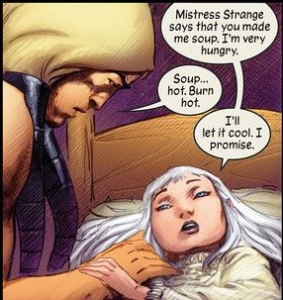 As I pointed out earlier, Marvel 1602 is a thickly layered story, juggling half a dozen plots and over a dozen characters at any given time. From a narrative standpoint, it’s fairly astounding that Gaiman keeps as many plates spinning at once as he does without fumbling one plot point in favour of other major ones. The plot at any given time follows Nicholas Fury with Peter Parquagh attempting to do the Queen’s work, the cessation of Queen Elizabeth’s reign in favour of King James’ rise, Matthew Murdoch travelling to Europe to track the Templar Knight, Otto Von Doom’s own machinations, the mysteries of Virginia Day as well as Rohjaz, the Inquisitor versus Javier Carlos’ witchbreed, and Doctor Stephen Strange’s attempts to stop the collapse of the 1602 reality. Like I said, plenty of things happening and even more characters associated with it all. The number of plots at play are always fluctuating as well, with Gaiman cleanly wrapping up every single plot at different intervals throughout the story to keep pushing the narrative forward.
As I pointed out earlier, Marvel 1602 is a thickly layered story, juggling half a dozen plots and over a dozen characters at any given time. From a narrative standpoint, it’s fairly astounding that Gaiman keeps as many plates spinning at once as he does without fumbling one plot point in favour of other major ones. The plot at any given time follows Nicholas Fury with Peter Parquagh attempting to do the Queen’s work, the cessation of Queen Elizabeth’s reign in favour of King James’ rise, Matthew Murdoch travelling to Europe to track the Templar Knight, Otto Von Doom’s own machinations, the mysteries of Virginia Day as well as Rohjaz, the Inquisitor versus Javier Carlos’ witchbreed, and Doctor Stephen Strange’s attempts to stop the collapse of the 1602 reality. Like I said, plenty of things happening and even more characters associated with it all. The number of plots at play are always fluctuating as well, with Gaiman cleanly wrapping up every single plot at different intervals throughout the story to keep pushing the narrative forward.
Marvel 1602 technically takes place during a fascinating period for the English language. When the story takes place, although not really referenced in the story, Shakespeare is at the height of his popularity, having developed many of his well-known tragedies like Macbeth, Hamlet, Romeo and Juliet, amongst other pieces in his catalog of fine work. As such, the story takes place in what is considered the era of Early Modern English, taking place from the 15th century to the late 17th century, all encompassed within the period of the English Renaissance. Early Modern English is a style of speaking and writing popularized during this time period that isn’t too complex for users of today’s Modern English (hence why we’re capable of understanding things like Shakespearean work). With all this in mind, it’s brilliance on the behalf of Gaiman to demonstrate that the language was slightly different during the conclusion of the Elizabethan era from what we understand today, modifying the parameters of certain characters’ way of speech. For example, you can immediately tell the language gap that takes place when someone like Rohjaz speaks versus Doctor Stephen Strange or Nicholas Fury. Strange has an almost scholar-like quality to his way of speech, but is still clear with his words. Fury, on the other hand, uses the language well but never descends into a series of words too complex for the reader. With Rohjaz, the words he uses are sharp and direct, showing that the English language is not his forte but still getting his point across because of which words he chooses. Another fine example is the way Ben Grimm (a.k.a. The Thing of Fantastic Four fame) speaks, having a surprising tempo and manner of speaking that is eloquent but slightly complex. His way of speaking is enough to hammer home the point that this all takes place in the Elizabethan period but is still at least somewhat different from everyone else’s way of speaking that you need to slow down and make sure you take in what it is he’s actually saying.
Collects: Marvel 1602 #1-8.
Best Character: Sir Nicholas Fury.
Best Line Of Dialogue/Caption: “I am in the heart of a mountain, far from here, a place to hold Earth and Air, Water and Fire…” – Doctor Stephen Strange.
Best Scene/Moment: The reveal at the end of issue 7 – Issue 7.
Best Issue: Issue 8. It should be a no-brainer that issue 8 is my choice for the best issue as it serves to conclude many of the hanging plot threads Gaiman has in a satisfying manner. Everything weaves together in the end, bringing together characters you didn’t think had a prayer of surviving with characters vital to the future world that is being established. Seemingly every character has their story paid off in one manner or another with the series tipping the hat of it’s major reveal and explaining everything you need to know. Every character gets what they deserve in this story that concludes in an admirable manner.
Why You Should Read It: This is historical fiction at its finest, combining real life events with the deep roster of fascinating Marvel characters to give you an almost academic take on the end of the Elizabethan era. It’s hard to stop talking about all the things this story does right when you start talking about them, whether it be how effectively Gaiman engages the reader into the setting, the fun takes on classic characters, or even the way the dialogue rolls cleanly. If you’re a fan of the Marvel Universe you should love this book. But if you’re a fan who loves being tricked into learning some fun history tidbits you’ll adore this book too. At the end of the day, this story shows why Neil Gaiman is a vital mind to the comic industry, as his creative outlook is invaluable to paving the road for future, ambitious stories.

